Abstract
1. The effects of autonomic stimulation on the release of vasoactive intestinal peptide (VIP) from the gastrointestinal tract have been investigated in adrenalectomized claves 2-5 weeks after birth.
2. Stimulation of the peripheral ends of the splanchnic nerves (10 Hz for 10 min) caused a small fall in the concentration of VIP in portal and arterial plasma, together with a rise in the concentration in intestinal lymph. None of these changes achieved statistical significance.
3. The effects of stimulation of the peripheral ends of the thoracic vagi, below the heart (10 Hz for 10 min), were found to depend in part upon the integrity of the splanchnic sympathetic innervation. A substantial rise in the concentration of VIP in intestinal lymph occurred whether or not the splanchnic nerves had been cut whereas an associated rise in arterial plasma VIP was only observed in calves in which the splanchnic nerves had been sectioned.
4. The rise in the concentration of VIP in intestinal lymph, in response to vagal stimulation, was unaffected by concomitant stimulation of the splanchnic nerves, although the associated rise in arterial plasma VIP concentrations was suppressed. The response was also found to be resistant to atropine.
5. The minimum estimated concentration of VIP in the extracellular fluid of the gastrointestinal tract was estimated to be about 60 p-mole/l. at rest and to rise by 70-120 p-mole/l. in response to vagal stimulation.
6. Intravenous infusions of VIP at a dose of 50 ng kg-1 min-1 (16 p-mole kg-1 min-1), which raised the minimum estimated concentration of VIP in the gastro-intestinal tract to the highest range encountered during stimulation, produced no significant changes in the concentrations of glucose, insulin, pancreatic glucagon or pancreatic polypeptide in the arterial plasma.
7. It is concluded that a small amount of VIP is released from the gastrointestinal tract in response to vagal stimulation. In contrast, release of VIP is unaffected by stimulation of the splanchnic nerves except in so far as the rate at which the peptide passes into the circulation is reduced by adrenergic vasoconstriction.
Full text
PDF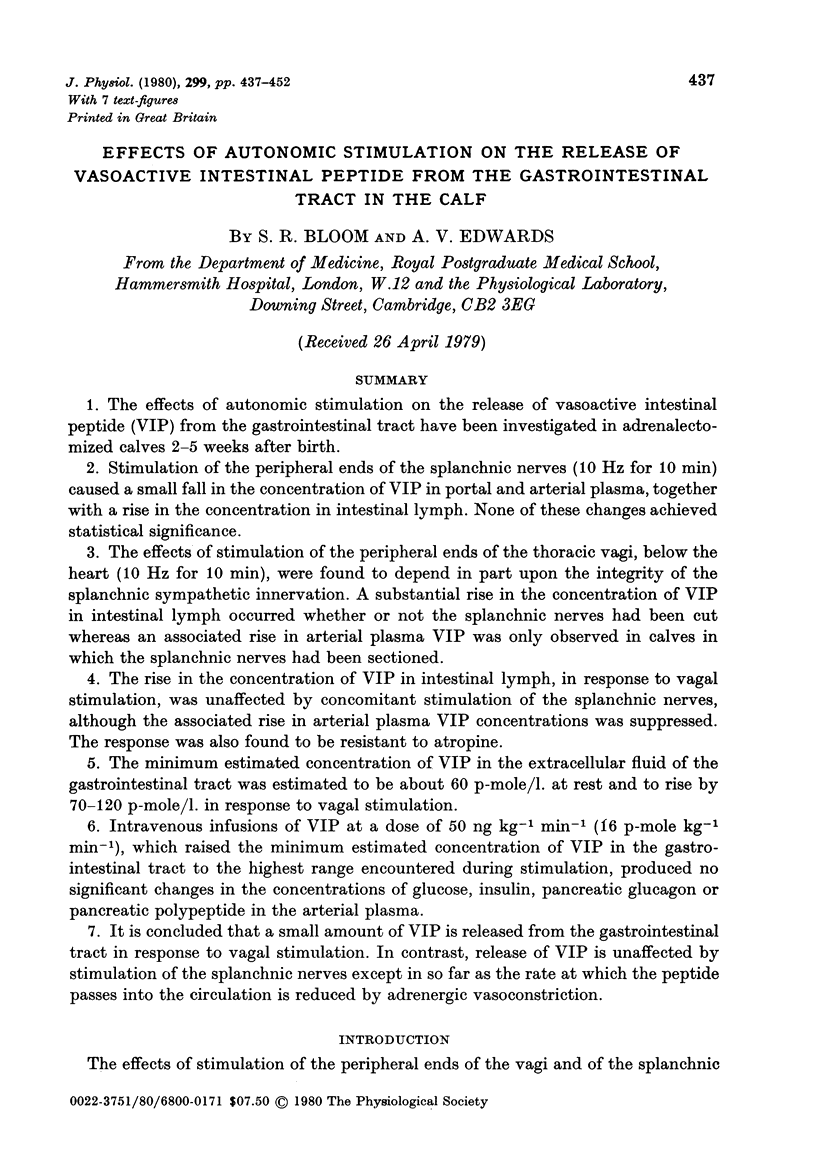
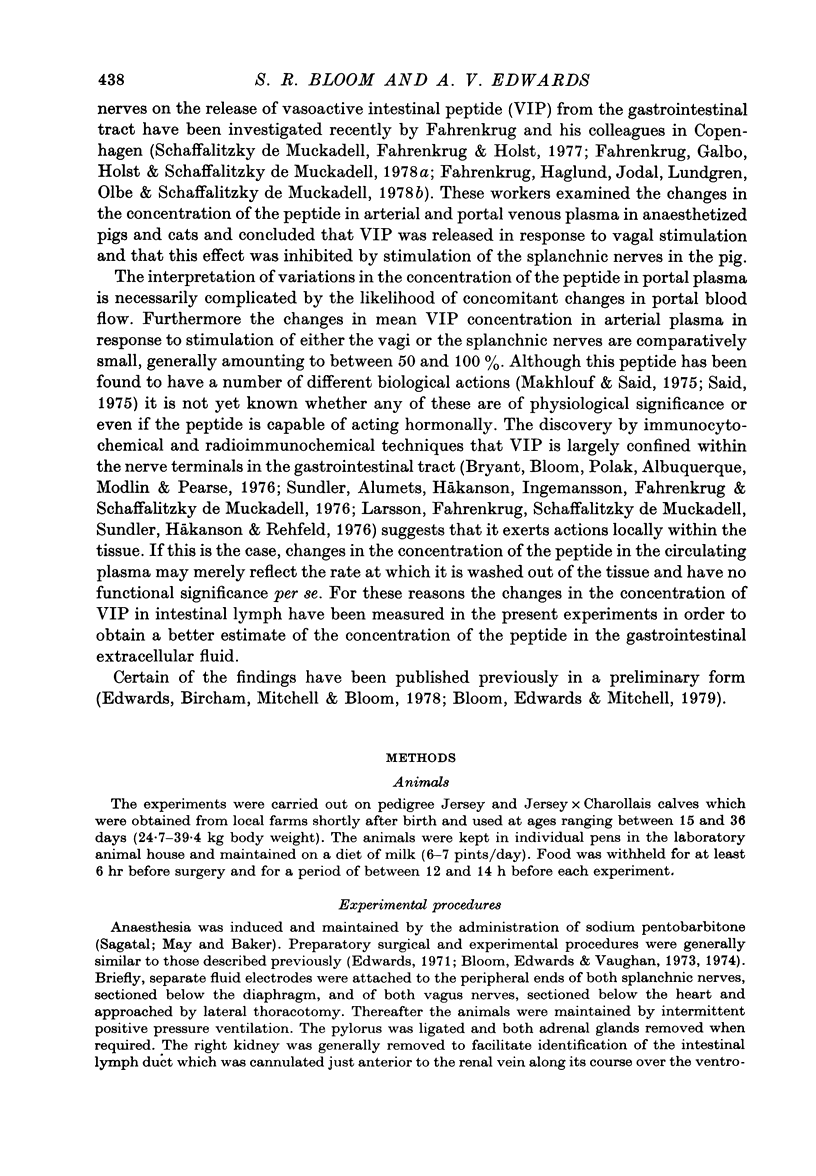
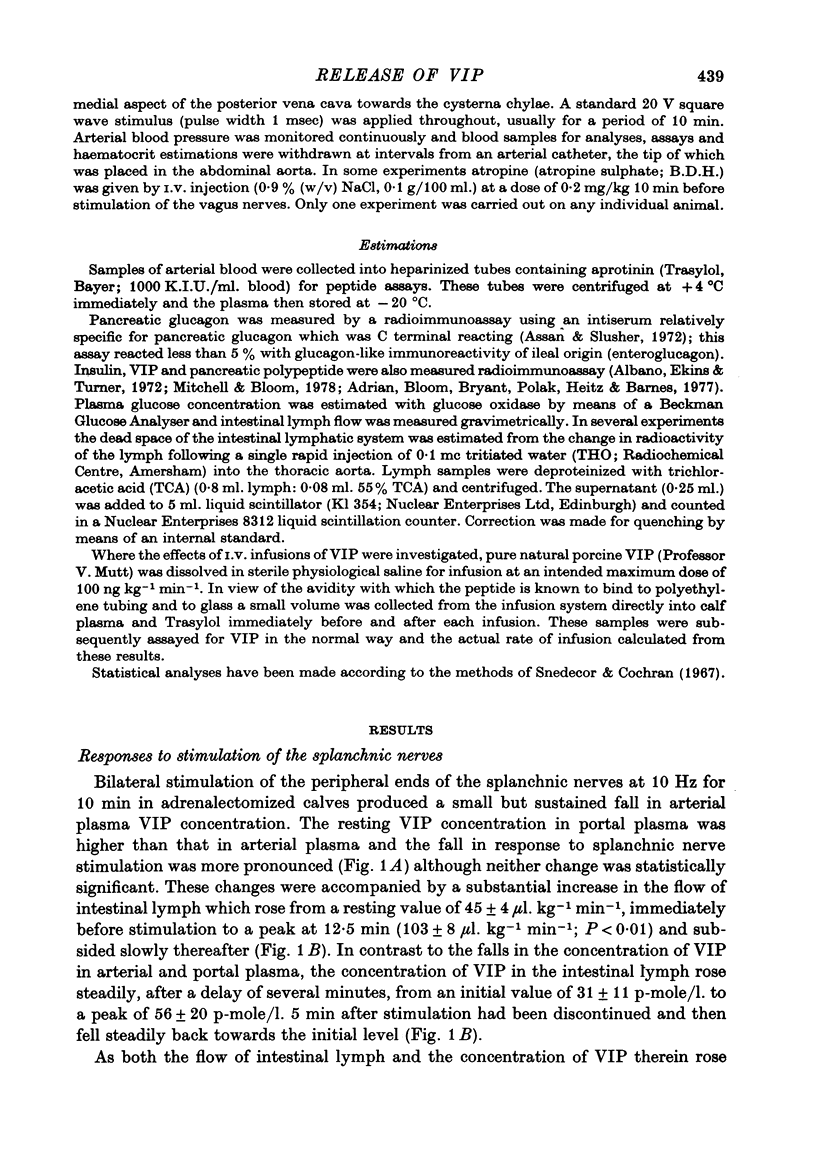
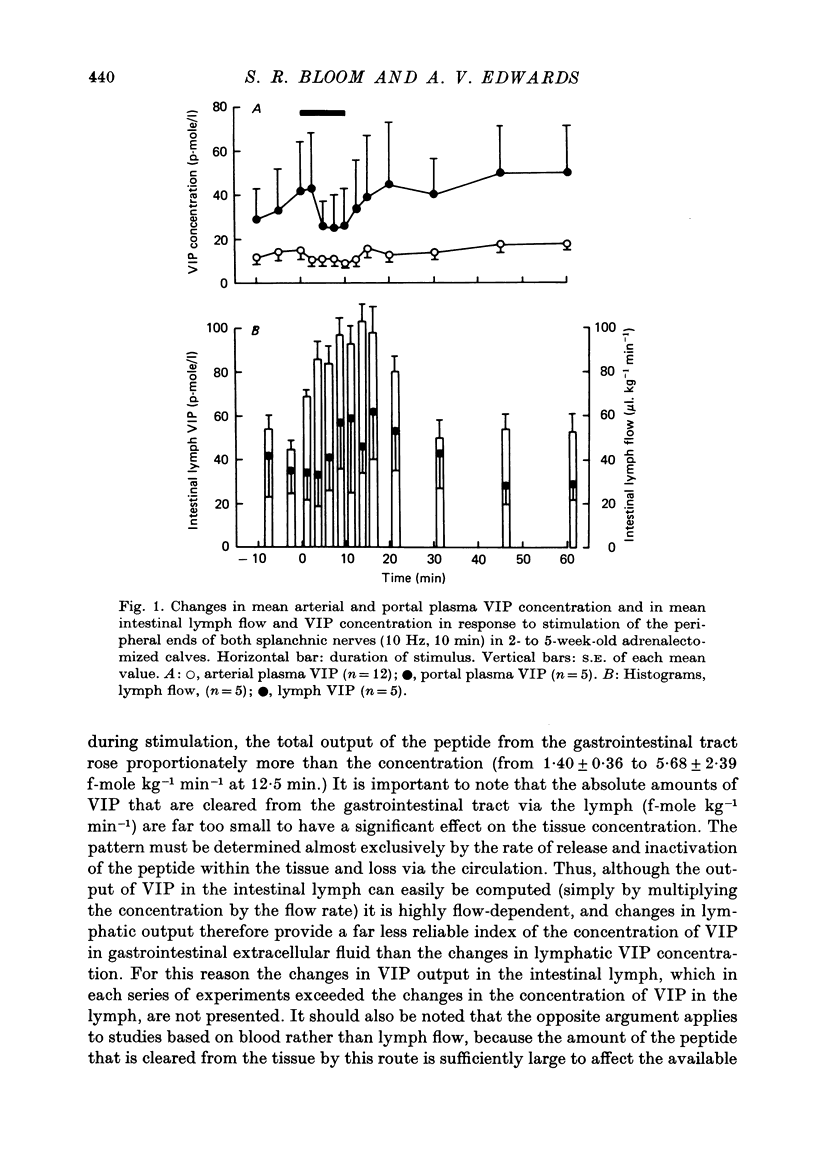
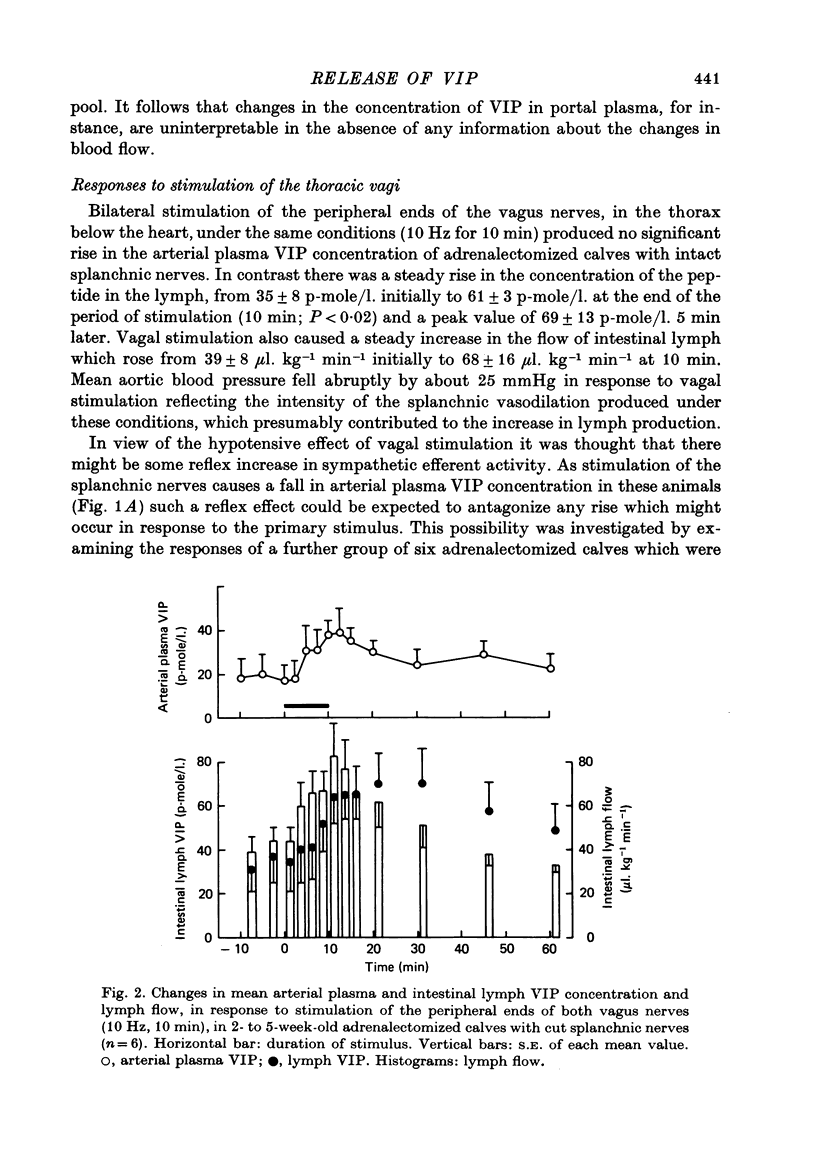
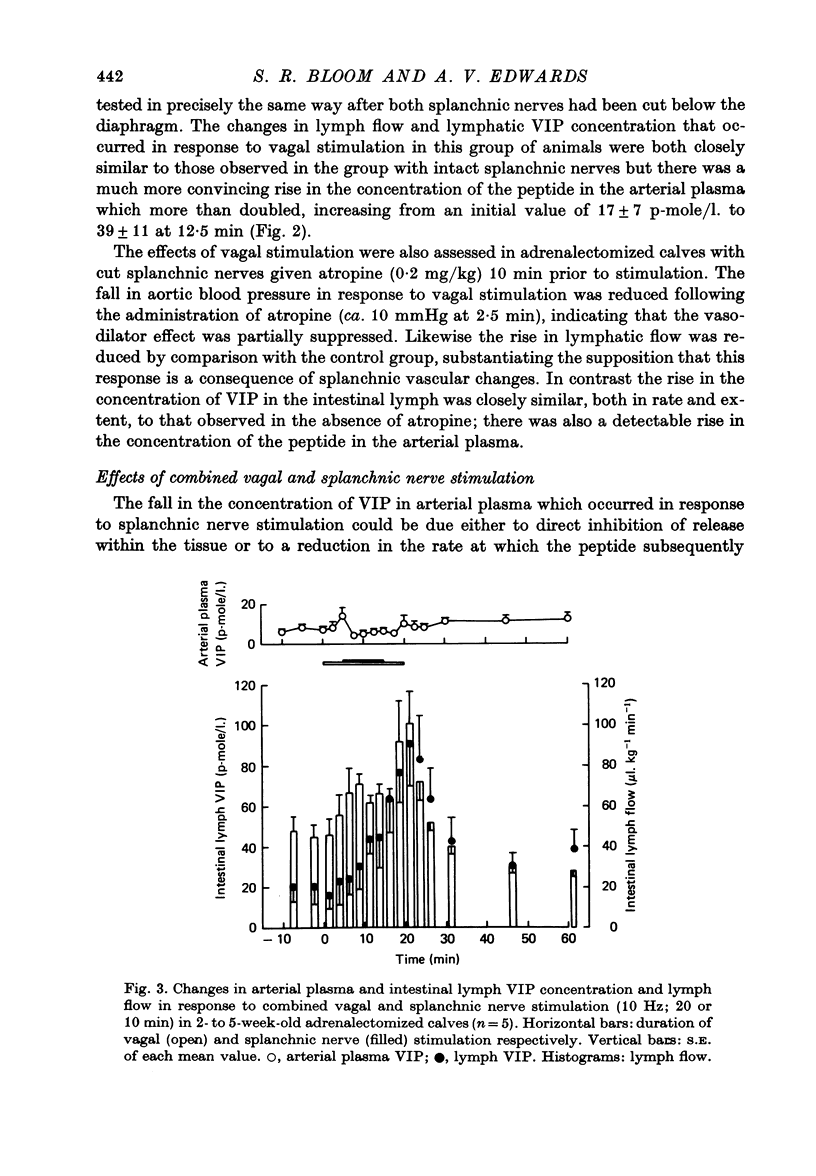
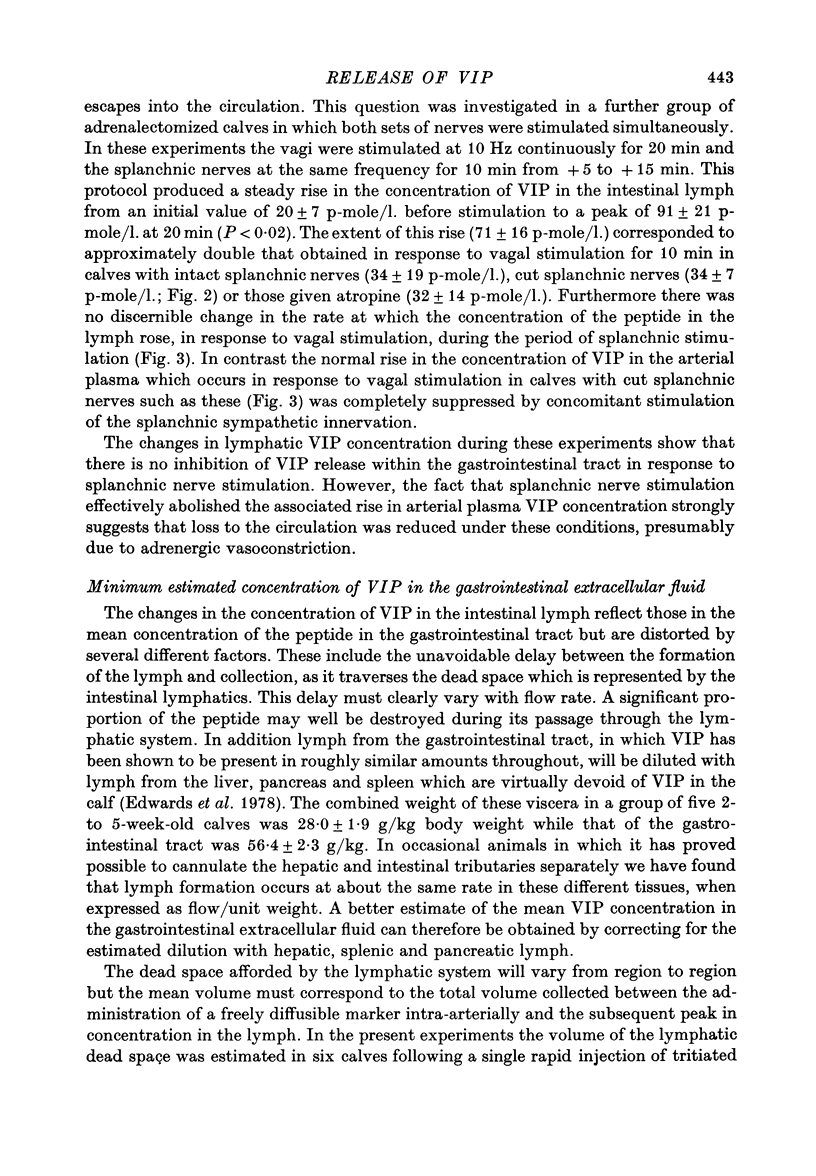
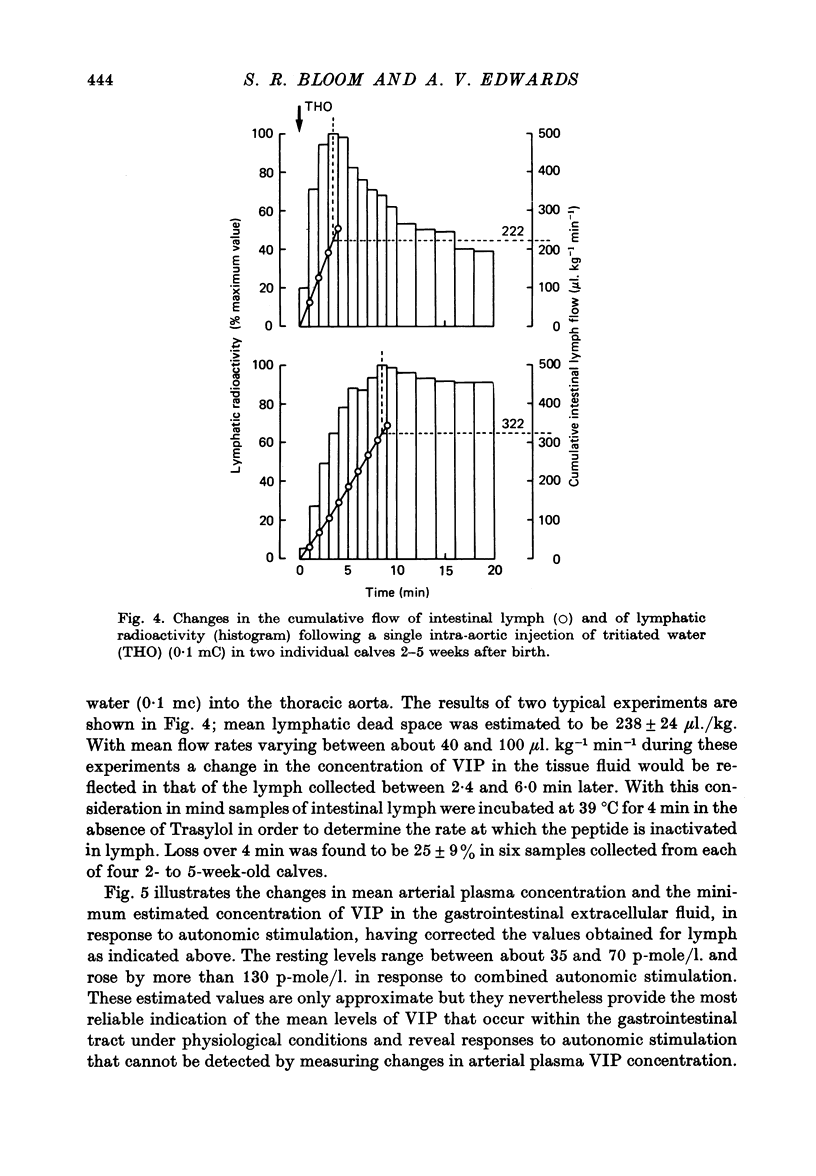
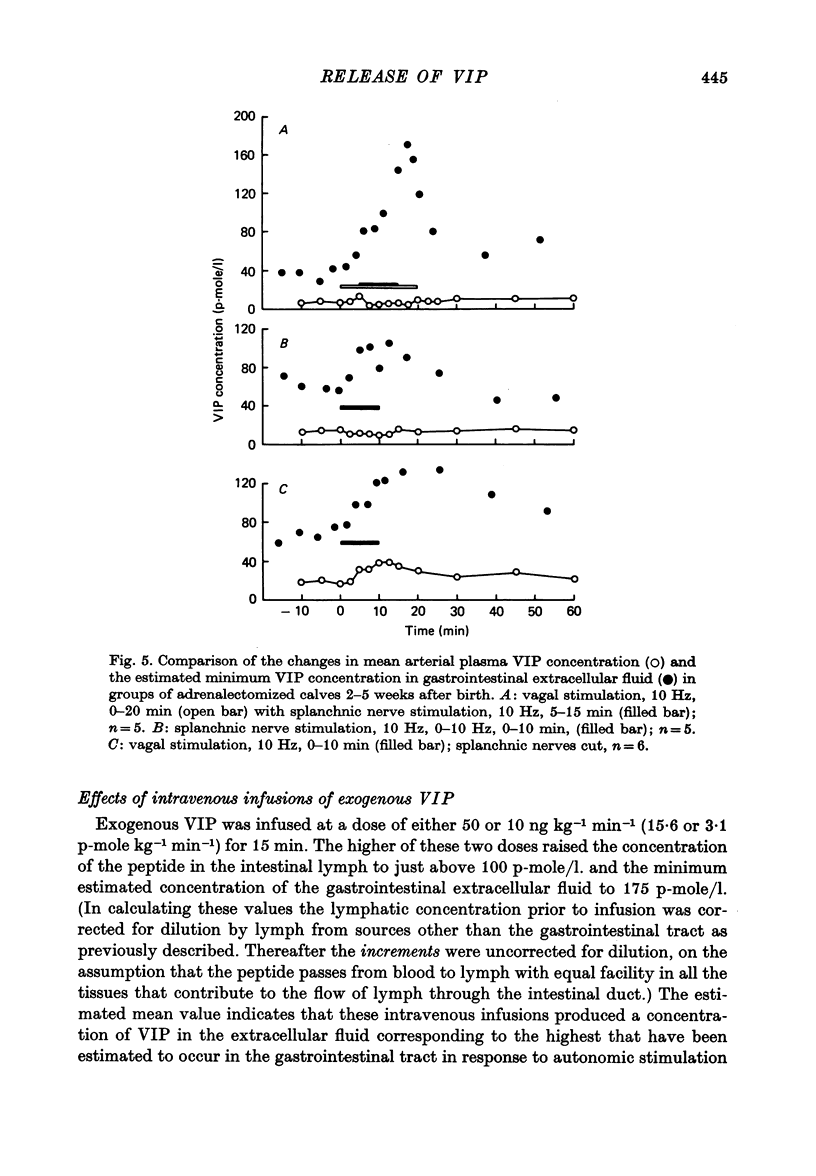
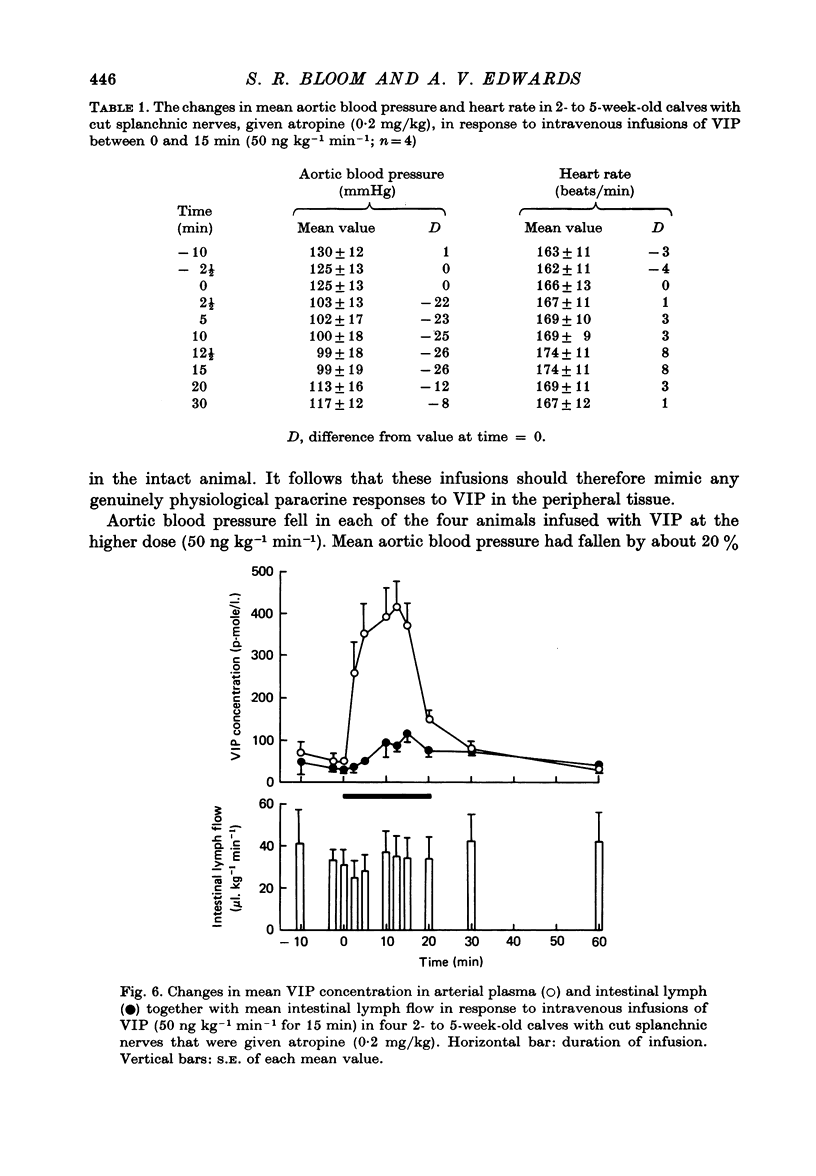
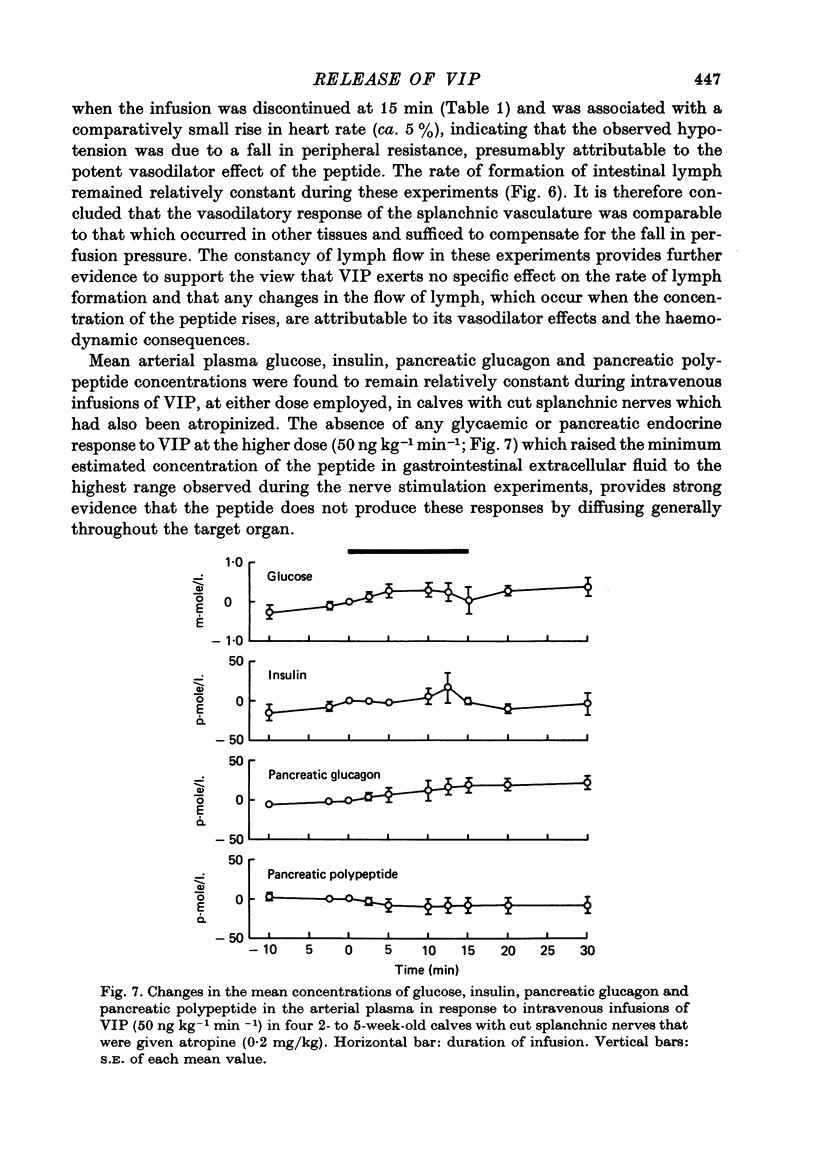
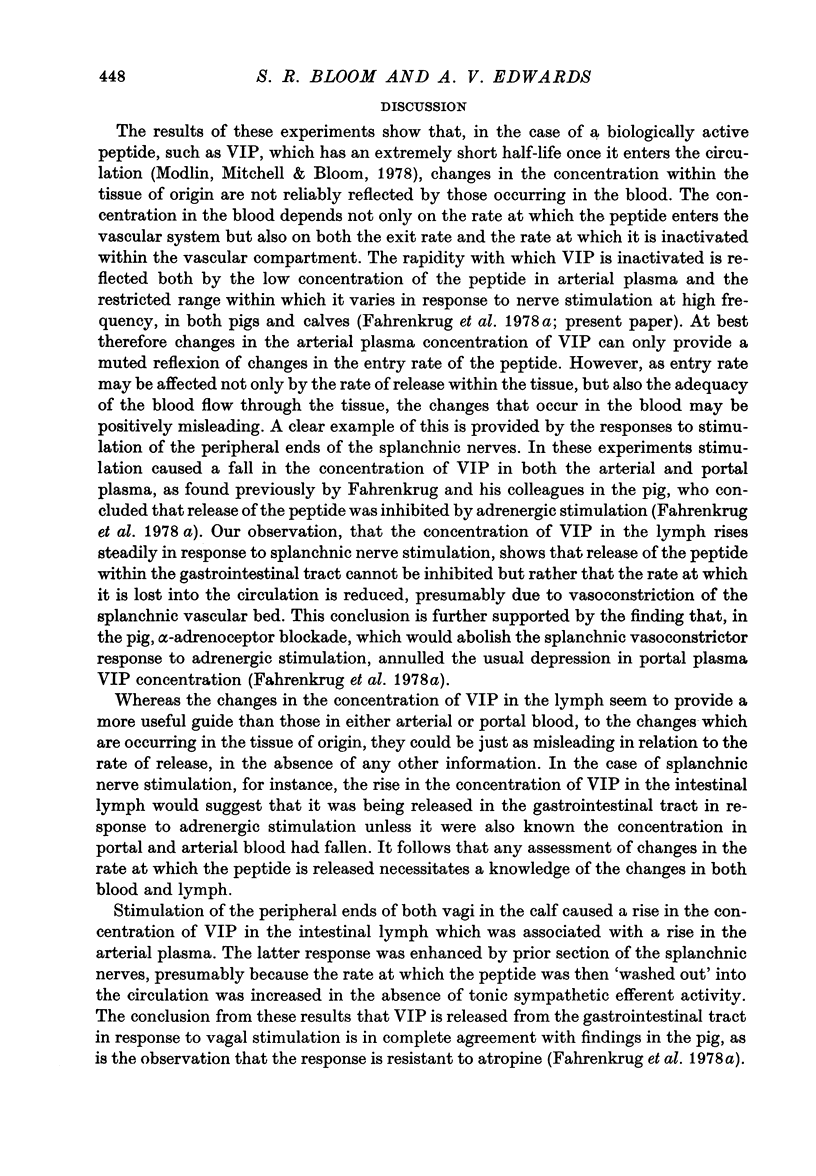
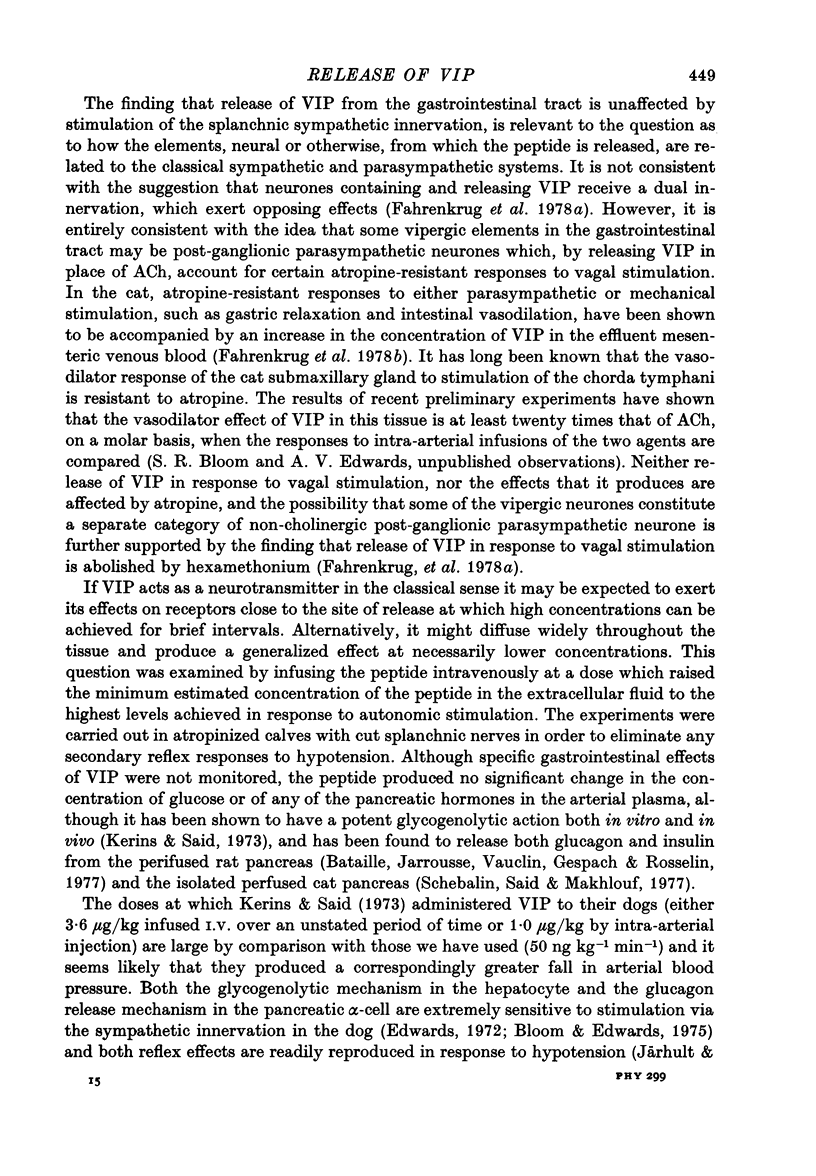
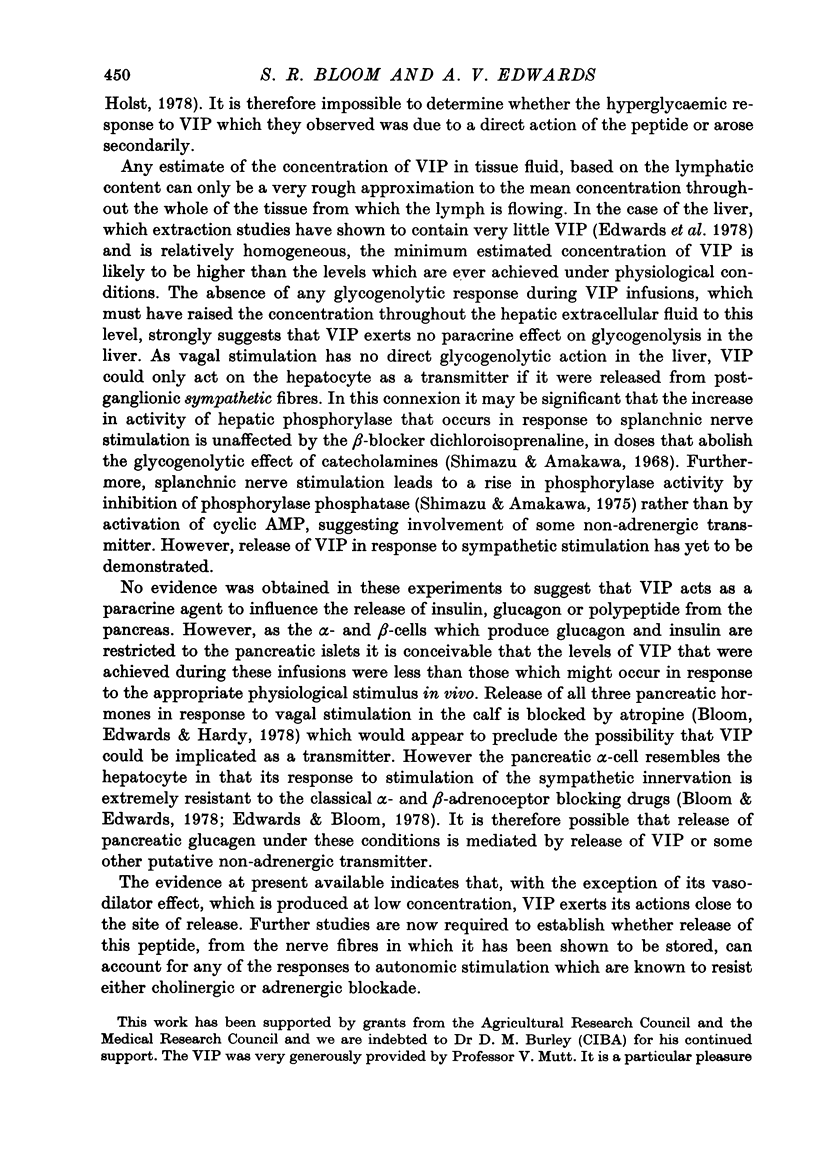
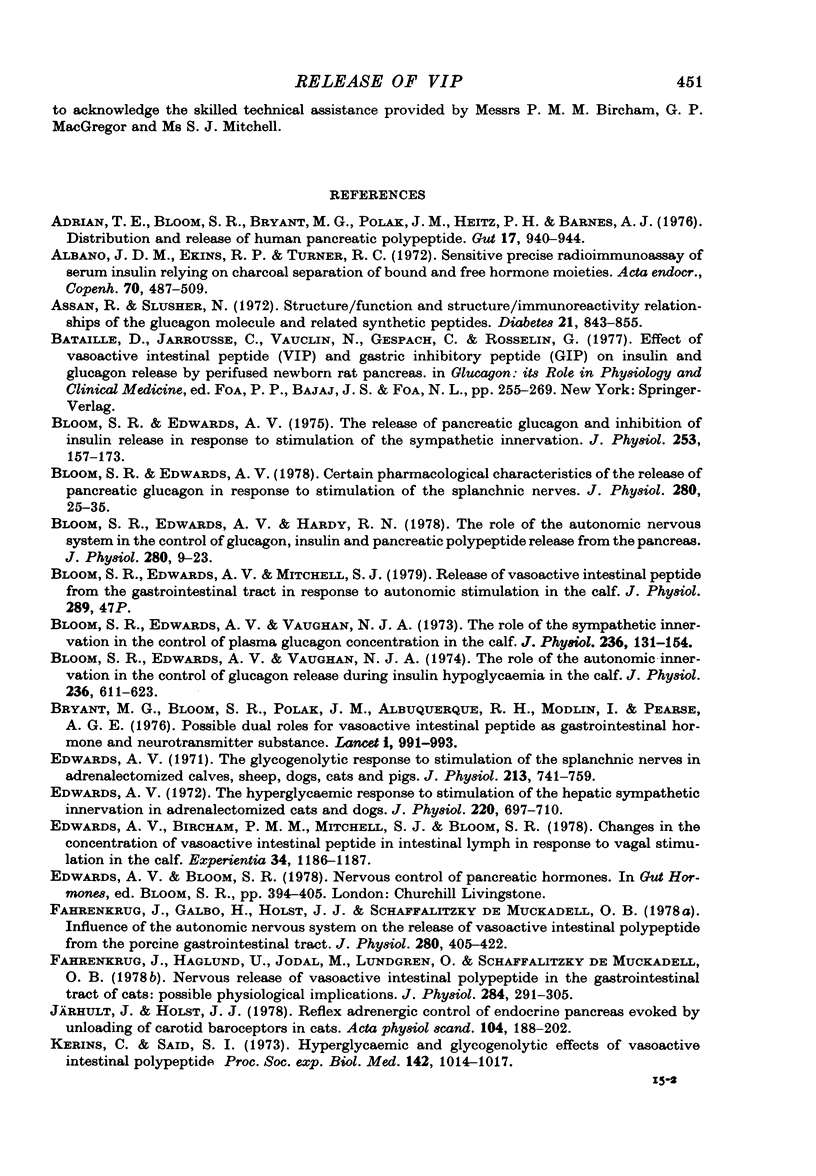
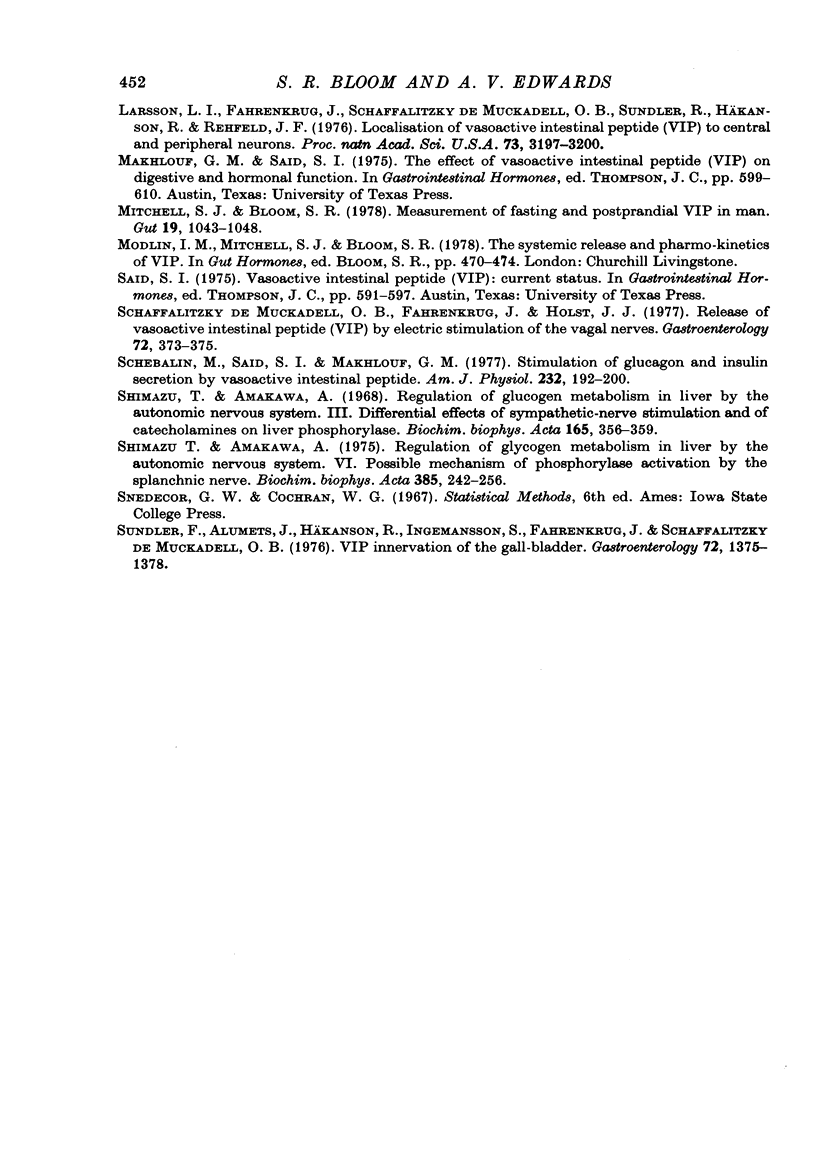
Selected References
These references are in PubMed. This may not be the complete list of references from this article.
- Adrian T. E., Bloom S. R., Bryant M. G., Polak J. M., Heitz P. H., Barnes A. J. Distribution and release of human pancreatic polypeptide. Gut. 1976 Dec;17(12):940–944. doi: 10.1136/gut.17.12.940. [DOI] [PMC free article] [PubMed] [Google Scholar]
- Albano J. D., Ekins R. P., Maritz G., Turner R. C. A sensitive, precise radioimmunoassay of serum insulin relying on charcoal separation of bound and free hormone moieties. Acta Endocrinol (Copenh) 1972 Jul;70(3):487–509. doi: 10.1530/acta.0.0700487. [DOI] [PubMed] [Google Scholar]
- Assan R., Slusher N. Structure-function and structure-immunoreactivity relationships of the glucagon molecule and related synthetic peptides. Diabetes. 1972 Aug;21(8):843–855. doi: 10.2337/diab.21.8.843. [DOI] [PubMed] [Google Scholar]
- Bloom S. R., Edwards A. V. Certain pharmacological characteristics of the release of pancreatic glucagon in response to stimulation of the splanchnic nerves. J Physiol. 1978 Jul;280:25–35. doi: 10.1113/jphysiol.1978.sp012370. [DOI] [PMC free article] [PubMed] [Google Scholar]
- Bloom S. R., Edwards A. V., Hardy R. N. The role of the autonomic nervous system in the control of glucagon, insulin and pancreatic polypeptide release from the pancreas. J Physiol. 1978 Jul;280:9–23. doi: 10.1113/jphysiol.1978.sp012369. [DOI] [PMC free article] [PubMed] [Google Scholar]
- Bloom S. R., Edwards A. V., Mitchell S. J. Release of vasoactive intestinal peptide from the gastrointestinal tract in response to autonomic stimulation in the calf [proceedings]. J Physiol. 1979 Apr;289:47P–47P. [PubMed] [Google Scholar]
- Bloom S. R., Edwards A. V. The release of pancreatic glucagon and inhibition of insulin in response to stimulation of the sympathetic innervation. J Physiol. 1975 Dec;253(1):157–173. doi: 10.1113/jphysiol.1975.sp011185. [DOI] [PMC free article] [PubMed] [Google Scholar]
- Bloom S. R., Edwards A. V., Vaughan N. J. The role of the autonomic innervation in the control of glucagon release during hypoglycaemia in the calf. J Physiol. 1974 Feb;236(3):611–623. doi: 10.1113/jphysiol.1974.sp010455. [DOI] [PMC free article] [PubMed] [Google Scholar]
- Bryant M. G., Polak M. M., Modlin I., Bloom S. R., Albuquerque R. H., Pearse A. G. Possible dual role for vasoactive intestinal peptide as gastrointestinal hormone and neurotransmitter substance. Lancet. 1976 May 8;1(7967):991–993. doi: 10.1016/s0140-6736(76)91863-8. [DOI] [PubMed] [Google Scholar]
- Edwards A. V., Birchman P. M., Mitchell S. J., Bloom S. R. Changes in the concentration of vasoactive intestinal peptide in intestinal lymph in response to vagal stimulation in the calf. Experientia. 1978 Sep 15;34(9):1186–1187. doi: 10.1007/BF01922948. [DOI] [PubMed] [Google Scholar]
- Edwards A. V. The glycogenolytic response to stimulation of the splanchnic nerves in adrenalectomized calves, sheep, dogs, cats and pigs. J Physiol. 1971 Mar;213(3):741–759. doi: 10.1113/jphysiol.1971.sp009412. [DOI] [PMC free article] [PubMed] [Google Scholar]
- Edwards A. V. The hyperglycaemic response to stimulation of the hepatic sympathetic innervation in adrenalectomized cats and dogs. J Physiol. 1972 Feb;220(3):697–710. doi: 10.1113/jphysiol.1972.sp009730. [DOI] [PMC free article] [PubMed] [Google Scholar]
- Fahrenkrug J., Galbo H., Holst J. J., Schaffalitzky de Muckadell O. B. Influence of the autonomic nervous system on the release of vasoactive intestinal polypeptide from the porcine gastrointestinal tract. J Physiol. 1978 Jul;280:405–422. doi: 10.1113/jphysiol.1978.sp012391. [DOI] [PMC free article] [PubMed] [Google Scholar]
- Fahrenkrug J., Haglund U., Jodal M., Lundgren O., Olbe L., de Muckadell O. B. Nervous release of vasoactive intestinal polypeptide in the gastrointestinal tract of cats: possible physiological implications. J Physiol. 1978 Nov;284:291–305. doi: 10.1113/jphysiol.1978.sp012541. [DOI] [PMC free article] [PubMed] [Google Scholar]
- Järhult J., Holst J. J. Reflex adrenergic control of endocrine pancreas evoked by unloading of carotid baroreceptors in cats. Acta Physiol Scand. 1978 Oct;104(2):188–202. doi: 10.1111/j.1748-1716.1978.tb06266.x. [DOI] [PubMed] [Google Scholar]
- Kerins C., Said S. I. Hyperglycemic and glycogenolytic effects of vasoactive intestinal polypeptide. Proc Soc Exp Biol Med. 1973 Mar;142(3):1014–1017. doi: 10.3181/00379727-142-37165. [DOI] [PubMed] [Google Scholar]
- Larsson L. I., Fahrenkrug J., Schaffalitzky De Muckadell O., Sundler F., Håkanson R., Rehfeld J. R. Localization of vasoactive intestinal polypeptide (VIP) to central and peripheral neurons. Proc Natl Acad Sci U S A. 1976 Sep;73(9):3197–3200. doi: 10.1073/pnas.73.9.3197. [DOI] [PMC free article] [PubMed] [Google Scholar]
- Mitchell S. J., Bloom S. R. Measurement of fasting and postprandial plasma VIP in man. Gut. 1978 Nov;19(11):1043–1048. doi: 10.1136/gut.19.11.1043. [DOI] [PMC free article] [PubMed] [Google Scholar]
- Schaffalitzky de Muckadell O. B., Fahrenkrug J., Holst J. J. Release of vasoactive intestinal polypeptide (VIP) by electric stimulation of the vagal nerves. Gastroenterology. 1977 Feb;72(2):373–375. [PubMed] [Google Scholar]
- Shimazu T., Amakawa A. Regulation of glycogen metabolism in liver by the autonomic nervous system. 3. Differential effects of sympathetic-nerve stimulation and of catecholamines on liver phosphorylase. Biochim Biophys Acta. 1968 Oct 15;165(3):349–356. doi: 10.1016/0304-4165(68)90212-2. [DOI] [PubMed] [Google Scholar]
- Shimazu T., Amakawa A. Regulation of glycogen metabolism in liver by the autonomic nervous system. VI. Possible mechanism of phosphorylase activation by the splanchnic nerve. Biochim Biophys Acta. 1975 Apr 7;385(2):242–256. doi: 10.1016/0304-4165(75)90352-9. [DOI] [PubMed] [Google Scholar]
- Sundler F., Alumets J., Håkanson R., Ingemansson S., Fahrenkrug J., Schaffalitzky de Muckadell O. VIP innervation of the gallbladder. Gastroenterology. 1977 Jun;72(6):1375–1377. [PubMed] [Google Scholar]


